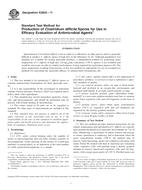Potřebujeme váš souhlas k využití jednotlivých dat, aby se vám mimo jiné mohly ukazovat informace týkající se vašich zájmů. Souhlas udělíte kliknutím na tlačítko „OK“.
ASTM E2800-11
Standard Practice for Characterization of Bacillus Spore Suspensions for Reference Materials
Automaticky přeložený název:
Standardní praxe pro charakterizaci Bacillus Spore suspenzí pro referenční materiály
NORMA vydána dne 15.2.2011
Informace o normě:
Označení normy: ASTM E2800-11
Poznámka: NEPLATNÁ
Datum vydání normy: 15.2.2011
Kód zboží: NS-46063
Počet stran: 8
Přibližná hmotnost: 24 g (0.05 liber)
Země: Americká technická norma
Kategorie: Technické normy ASTM
Kategorie - podobné normy:
Anotace textu normy ASTM E2800-11 :
Keywords:
Bacillus, phase contrast microscopy, plate count, spores, ICS Number Code 07.100.99 (Other standards related to microbiology)
Doplňující informace
| Significance and Use | ||||||||||||||||||||
|
Standard practices for the characterization of spores used as reference materials are important to ensure a uniform basis for testing the performance of detection devices and laboratory instruments. Bacillus spore suspensions can be used for a large variety of purposes including testing environmental sampling techniques, inactivation methods, decontamination methods and basic research. The practice is intended for both manufacturers and end users of Bacillus spore suspensions. The results of the characterization measurements are presented in a report of analysis (ROA). The ROA should provide sufficient detail about the measurement technique to enable the customers to replicate the measurements, allowing them to determine if the properties of the spore suspension changed during shipping and storage. The enumeration of the viable spores and determination of homogeneity by microscopic analysis are two basic measurements required for the minimal characterization of reference materials. Phase contrast microscopy does not require staining to distinguish the “phase bright” dormant spores from phase dark spores, dark vegetative cells and clumps. When spores germinate they appear phase dark under phase contrast imaging (5). Germinated spores in a reference sample will soon die due to lack of nutrients. It is important in storing samples to prevent the premature germination of the spores. This standard practice includes the important steps for these measurements and includes guidance for advanced measurements. Additional guidance is given for advanced techniques to characterize spore suspensions that may be used to provide a higher level of characterized Bacillus spore reference samples. The specific properties of the spores used for their intended application, such as susceptibility to disinfectant processes, should be determined in addition to the basic measurements covered in this practice. Additional information on the measurement of spore properties is located in the appendix. |
||||||||||||||||||||
| 1. Scope | ||||||||||||||||||||
|
1.1 This practice is focused on two basic measurements to characterize Bacillus reference materials, the enumeration of spores using growth of colonies on nutrient media and using phase contrast microscopy to determine spore quality and homogeneity. Additional information on advanced methods for characterization is provided in Appendix X1. 1.2 This document will provide the user with recommendations for measurement methods, and the details and conditions that should be employed to ensure reliable and high-quality data are obtained. The practice will help ensure that results obtained from the characterization are reported in a uniform manner. This will allow others to replicate the measurements and facilitate the comparison of different lots of Bacillus spore suspensions used as reference materials. It is important to note that the Bacillus species are a heterogeneous group and their specific requirements for growth and sporulation may vary. Users of this practice are encouraged to consult the literature for specific information on the species of Bacillus bacteria they are using (1). 1.3 This standard practice does not provide guidance for the identification of unknown species of bacteria. The identification of Bacillus species has been traditionally based on colony morphology, growth on selective media, and biochemical tests, but more recently nucleic acid technologies have enabled the phylogenetic analysis of this group based on 16S DNA sequence similarities (1). 1.4 Some Bacillus spp. are pathogenic to humans and animals and the user is advised to adhere to safe laboratory procedures and practices for handling spores from these species (2).This standard does not purport to address all of the safety concerns, if any, associated with its use. It is the responsibility of the user of this standard to establish appropriate safety and health practices and determine the applicability of regulatory limitations prior to use (2). 1.5 This practice assumes a basic knowledge of microbiology and molecular biology and access to the cited references. 1.6 The values stated in SI units are to be regarded as standard. No other units of measurement are included in this standard. |
||||||||||||||||||||
| 2. Referenced Documents | ||||||||||||||||||||
|
Podobné normy:
Historická
1.12.2011
Historická
1.8.2011
Historická
1.10.2013
Historická
15.11.2012
Historická
15.11.2012
Historická
1.8.2008



 ASTM E2657-11
ASTM E2657-11 ASTM E2839-11
ASTM E2839-11 ASTM E2895-13
ASTM E2895-13 ASTM E2896-12
ASTM E2896-12 ASTM E2897-12
ASTM E2897-12 ASTM F2739-08
ASTM F2739-08
 Cookies
Cookies
